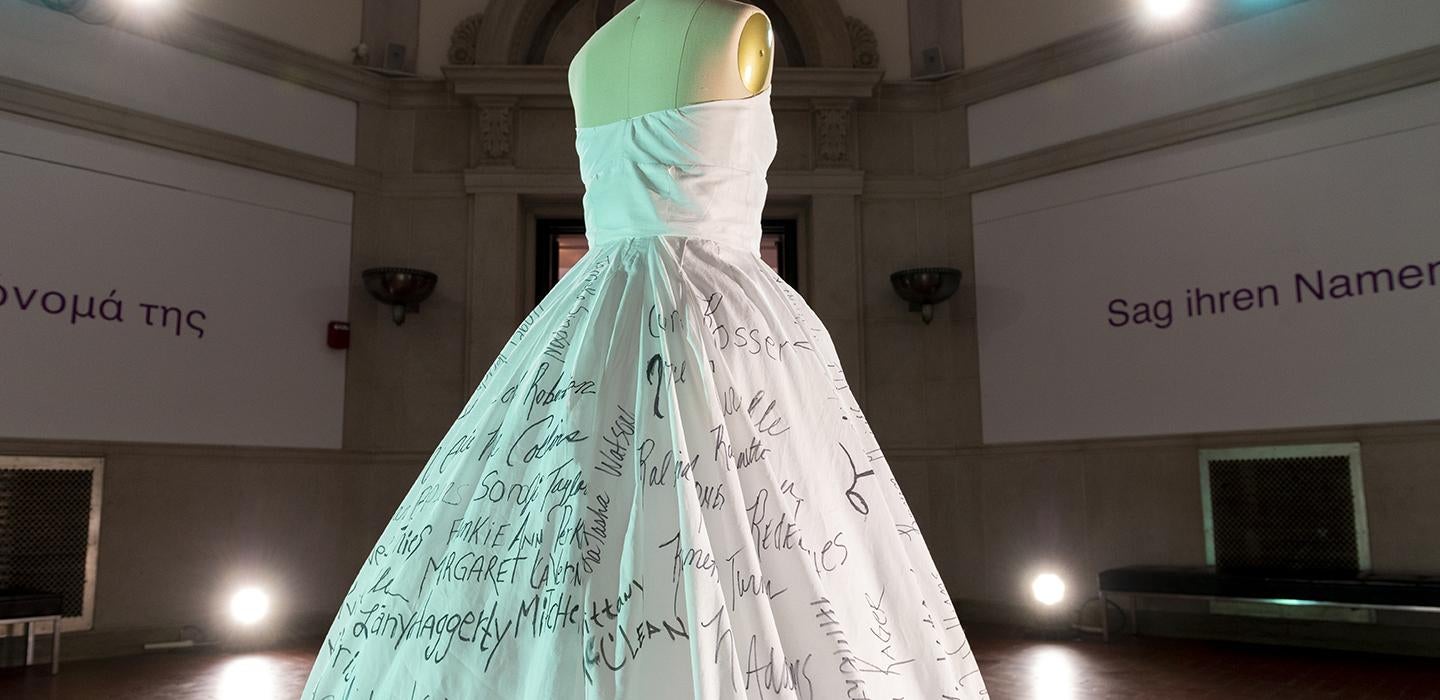
Subscribe to Pittwire Today
Get the most interesting and important stories from the University of Pittsburgh.A Pitt art exhibit is yet another example this week of using fashion as a social statement.
The Say Her Name Memorial Gown, one of four inaugural projects of the Black Lives in Focus Initiative, is now on display at the University Art Gallery in the Frick Fine Arts Building.
Lecturer Karen Gilmer’s sculpture, made of white cotton Baptiste fabric in homage to the Black enslaved people who once picked cotton, is emblazoned with the names of Black women killed by police.
“As I said the names, I let the gown and woman speak to me as to how she wanted her name written,” said Gilmer, who teaches costume design in the Department of Theatre Arts within the Kenneth P. Dietrich School of Arts and Sciences.
The gown features about 100 names, chosen by Gilmer who referred to the #SayHerName list, Ebony and Jet magazines and other social media sources. Of the names written in the gown are: Breonna Taylor, Cynthia Wesley, Catawaba Howard, Sarah Riggins, Beatrice Randolph, Shelley Amos and Erica Collins.
The exhibit also features audio of Tyler Cruz (A&S ’17) reading the list the Black women memorialized, adding texture to the viewing experience.
Like many of the designs adorning celebrities at Monday’s Met Gala in New York City, Gilmer’s work is more than a dress. She said it “celebrates, uplifts and memorializes the women who were taken through state violence.”
Years later, as Gilmer mulled over an idea for a gown memorializing women victims of police violence, she recalled an advertisement in the magazines of her childhood for menstrual products featuring groundbreaking Black model Helen Williams in a full-skirted evening gown. That gown, worn by Williams, inspired the design of Gilmer’s Say Her Name Memorial Gown.
The installation received financial support from several Pitt units, including the Center for Bioethics and Health Law. While the connection between fashion and bioethics might not be immediately apparent, the study of bioethics is broadening as an academic field that, “recognizes that human health and human flourishing depend on more than just good medical care or the fruits of medical research; it is dependent on social factors, on how we treat each other and on social institutions,” Director Lisa Parker said.
“Gilmer’s work sparks discussion,” Parker added, “and creates conversation in creative ways about the way Black people have been treated in our country.”
The Say Her Name Memorial Gown will be on display from noon to 4 p.m. Sept. 14-24 at the University Art Gallery on the Pittsburgh campus.
Also be sure to view the Black Lives in Focus art exhibit installed on the lawn of the Cathedral of Learning through Sept. 23. Another upcoming project of the Black Lives in Focus Initiative includes the launch of the Black Built Pitt, a multimedia tour of historically important sites of Black history on the University’s Pittsburgh campus.
The Say Her Name Memorial Gown is presented with the University of Pittsburgh’s Office for Equity, Diversity, and Inclusion, the Center for Creativity, the Department of Theatre Arts, the University Art Gallery and the Year of Engagement.
— Nichole Faina


